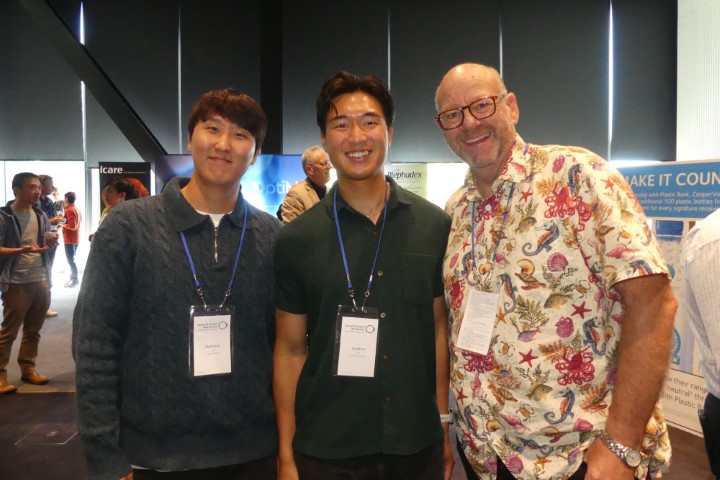Global trends in retina
According to the American Society of Retina Specialists’ (ASRS’s) 2018 Global Trends in Retina survey, a majority of respondents in all regions said they had learned a new technique via online video less than 24 hours before performing it. The trend was greatest in Africa/Middle East (72.6%), followed by Central & South America (67.6%), Europe (62.4%) and Asia/Pacific (58.6%), with respondents in the United States (US) only slightly more likely to do so than not (53.8%).

Chairman of the ASRS’s international affairs committee, Dr Rishi Singh, said 922 respondents from 42 retina societies around the world participated in the survey this year, with not all respondents answering every question.
In the majority of regions respondents felt the greatest unmet need regarding wet age-related macular degeneration (wet AMD) treatment was the availability of long-acting/sustained delivery options (between 78.3% in Africa/Middle East and 66.5% in Central & South America), with those in the US (73.2%) and Asia/Pacific (69.1%) indicating reduced treatment burden as the greatest need.

The survey also found the first-line anti-vascular endothelial growth factor (anti-VEGF) agent for wet AMD in Africa/Middle East and the United States was bevacizumab (Avastin), at 79.3% and 70.2% respectively, with afibercept (Eylea) the leading option in Asia/Pacific (41.7%), Central & South America (47.3%) and Europe (37.2%). In those regions where bevacizumab was the first choice, aflibercept was the second choice. In those regions where aflibercept was the first choice, bevacizumab was the second choice with the exception of Central and South America, where ranibizumab was preferred over bevacizumab.

The majority of respondents said they would consider switching anti-VEGF agents due to inadequate response after three to six injections: 91.4% in Africa/Middle East, 81.9% in Central & South America, 81.2% in Asia Pacific, 78.1% in the United States and 73.7% in Europe.

Treatment preference for a submacular haemorrhage due to AMD with visual acuity (VA) =20/200 varied, with Africa/Middle East (37.1%) favouring vitrectomy with tissue plasminogen activator (t-PA) injection over anti-VEGF injection therapy, while the majority of other regions opted for anti-VEGF injection over vitrectomy with t-PA: (US 56.8%), Central & South America (54.5%) and Asia/Pacific (34.5%). In Europe preference for the two options was almost evenly split.

The survey asked how respondents would treat a mildly symptomatic central retinal vein occlusion (CRVO) with minimal thickening on optical coherence tomography (OCT), VA=20/25. Treatment options available were; observation, as most cases resolve spontaneously; immediate anti-VEGF, as most eyes will worsen; and defer treatment until the macular oedema or VA worsens. Responses varied, with those in Central & South America most likely to opt for observation, those in Africa/Middle East most likely to choose immediate anti-VEGF treatment, and those in the US most likely to defer treatment until symptoms worsen.

The survey also asked how the six-month Diabetic Retinopathy Clinical Research Network's (DRCR.net’s) Protocol U results affected respondents’ management of eyes with diabetic macular oedema poorly responsive to ranibizumab. 50.2% of respondents in the US, 48.2% in Africa/Middle East and 29.6% in Asia/Pacific said they would not change, while 38.0% of those in Central & South America and 36.5% in Europe said they were more likely to continue anti-VEGF injections prior to switching to corticosteroid. No respondents indicated they were more likely to switch to corticosteroid earlier over continuing anti-VEGF injections.

Respondents were asked how they would manage a 30-year-old type 1 diabetic patient with high-risk proliferative diabetic retinopathy (PDR), VA=20/20, and no macular oedema. “Complete panretinal photocoagulation (PRP) treatment in two or more sessions” was the preferred option except in Central & South America, where “anti-VEGF injection therapy in conjunction with complete PRP treatment in two or more sessions” was slightly more popular, and the US, where preference was almost evenly split between both options.

Asked what their first-line treatment for symptomatic vitreomacular traction (VMT) with focal vitreous traction (<200 µm) and a small macular hole, VA=20/50, by far the majority in all regions bar Africa/Middle East opted for surgical intervention over observation, with a much narrower gap in Africa/Middle East (42.1% surgical intervention, 39.1% observation).

Respondents in every region bar the US said they had not used 3D heads-up visualisation systems in the operating room (OR) but planned to in future. In the US, respondents choosing this option were more or less matched by those saying they have not used it in the OR but do not think it is helpful. In Asia/Pacific, 15.1% and the US, 17.6% have used it in the OR and do not think it is helpful, while in all other regions those who have used it in the OR range from 16.6% - 24.1% and think it has been helpful.

By far the majority of respondents in all regions (70.2%-89.7%) also said they had not used intraoperative OCT.

The majority of respondents in all regions (44.1%-55.4%) also said they performed pneumatic retinopexy less than once a month.
36.2%-49.1% across all regions said they had never tried no-face-down positioning after macular hole surgery but had thought about it.
When asked which local anaesthetic they preferred for transconjunctival sutureless vitrectomy, respondents from all regions strongly favoured a peribulbar injection, except for Asia/Pacific where retrobulbar injection was more popular. In all regions, the least favoured option was sub-tenon’s injection.
Respondents varied in choice of tamponade following diabetic tractional retinal detachment repair if they did not identify/induce any retinal breaks, with those in Africa/Middle East, the US and Asia/Pacific preferring no tamponade, just balanced salt solution and those in Europe and Central & South America opting for complete air fill.
Pictures originally published in of ASRS’ 2018 Global Trends in Retina.
























